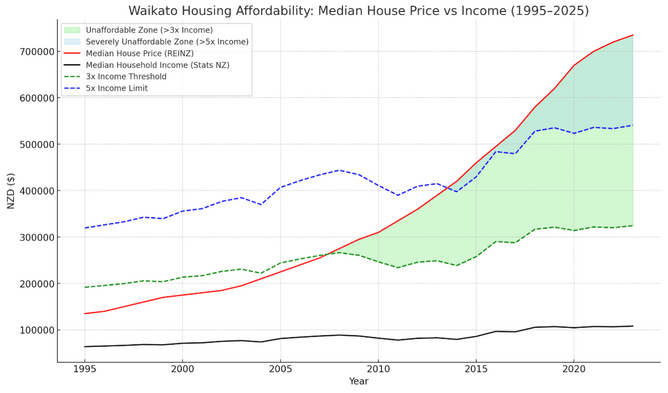The WWP has been working across a number of different wellbeing domains (for example food security and youth wellbeing)- many of which have consistently pointed back to the price of housing as a key factor which undermines household wellbeing and prosperity. This month, our Lots of Little Fires story on The Serve has underlined the effect of unaffordable housing on food insecurity, while the Child Poverty Action Group (Child Poverty Action Group | Scoop InfoPages) has recently restated the effects of low income and unaffordable housing, amongst other factors.
Housing Affordability: Still Out of Reach for Many
Waikato's housing market is increasingly excluding working families, with housing costs far outpacing income growth and rents consuming a disproportionate share of earnings. Work which the WWP has undertaken outlines the structural challenges and proposes equity-driven, place-based policy responses supported by regional data.
Key regional indicators—such as the median house price of $740,000 and a regional median household gross income of $116,722—reveal a price-to-income ratio of approximately 6.4:1, signalling a deepening affordability crisis across the Waikato region. These structural imbalances entrench long-term financial stress, limit pathways to home ownership, and reflect a systemic decoupling of housing costs from local income realities.
If house prices continue to grow faster than incomes, the time required to save a deposit will stretch from 13 years today to 21 years by 2035 and 28 years by 2045. Without intervention, housing will continue to drift further out of reach for many, entrenching long-term inequality and financial stress. The analysis confirms that Waikato's housing system—already unaffordable for many—is structurally exclusionary, shaped by income disparities, geography, and policy design gaps.
Housing affordability is no longer an abstract metric—it is a barometer of inequality, wellbeing, and economic mobility. Nowhere is this truer than in Waikato. Historically affordable and a hub for essential workers and young families, the region has experienced a structural divergence between incomes and housing costs.
Looking further back, the historical record tells a clear story. Over the past 30 years, homeownership in the Waikato region has become increasingly out of reach, not simply due to rising house prices, but because household incomes have not kept pace. While affordability remains stretched, recent data show slight improvements compared to the peak in 2021–2022, due to stabilising house prices and modest income growth.
The figure below visualises the growing affordability gap in Waikato's housing market over the past three decades. It compares the median house price (in red) with the median household income (in black), alongside two internationally recognised affordability thresholds:
The green dashed line represents three times the median income, a standard benchmark for maximum affordable house price.
The blue dashed line represents five times the income, often considered the upper limit beyond which housing is deemed severely unaffordable
In 1995, median house prices were approximately three times the income, consistent with a healthy market. However, from around 2003 onwards, house prices began outpacing income growth, breaking past affordability thresholds. By 2025, the gap between income and house prices has widened dramatically, with prices exceeding 6 times the median household income, making most homes unaffordable for average earners.
Waikato Housing Affordability – Median House Price vs Household Income (1995–2025)
This chart clearly illustrates that the challenge is not just rising prices, but the decoupling of housing costs from local income realities. Without a significant structural shift, this affordability chasm will continue to grow, entrenching inequality and locking out future generations from homeownership.
The data reflects a fundamental shift: what was once a plausible pathway to homeownership in the early 2000s has become a prolonged and increasingly unreachable goal. Even without projecting into the future, the historical evidence reveals a steady erosion of affordability over a single generation.
We will be sharing more information about affordability and its impacts on wellbeing very shortly. This will be followed up by research we are currently commissioning on what it will take to make housing more affordable for people in the Waikato. This is scheduled for completion by October.


